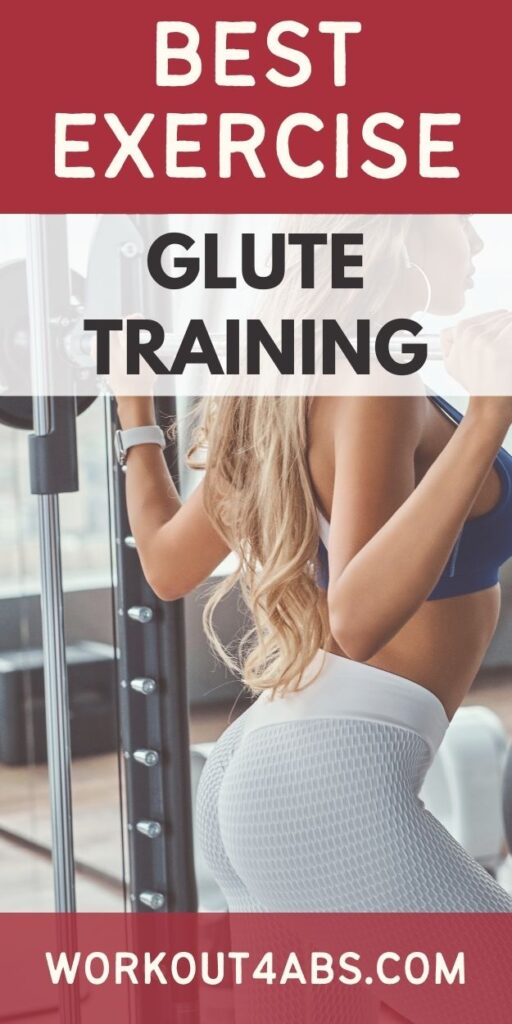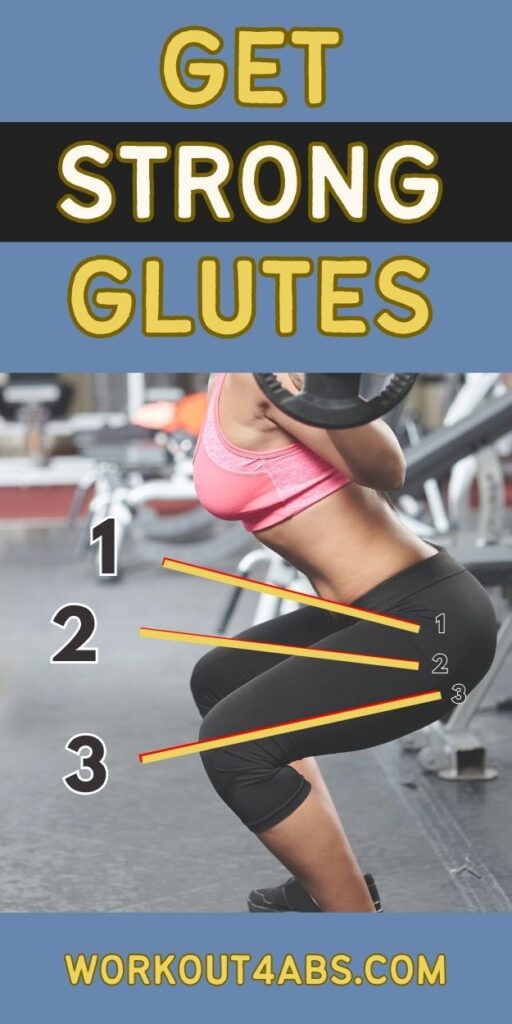Are you ready to explore the best exercises for glute growth for achieving those coveted glute gains? Here, we explore the top exercises renowned for fueling glute growth, including the barbell split squat, stiff-legged deadlift, and barbell squat. Discover the keys to sculpting strong and shapely glutes that turn heads.
Grow Your Glutes With These Science-based Exercises (no Hip Thrusts Required)
If you enjoyed these tips, please save this pin to your Pinterest Board.

Barbell Split Squat
In a barbell split squat, the goal is to distribute most of your body weight onto the front foot for several reasons:
- Muscle Targeting: Placing the majority of your weight on the front foot ensures that the front leg (usually the one forward) bears the brunt of the load. This intensifies the workout for the quadriceps, hamstrings, and glutes, making it an effective lower body strength exercise.
- Balance and Stability: Shifting your weight forward helps maintain balance and stability during the exercise. When most of your weight is on the front foot, you can better control your body and the barbell, reducing the risk of falling or losing control.
- Proper Alignment: Loading the front leg encourages proper alignment of your knee and ankle joints, reducing the stress on your knee. This can help prevent potential knee discomfort or injury.
Here’s how to perform a barbell split squat with proper weight distribution:
- Setup: Start by placing a barbell across your upper back (using a squat rack or a Smith machine) and stand in a split stance. Your feet should be a comfortable distance apart, with the front foot about 2-3 feet in front of the rear foot.
- Weight Distribution: As you descend into the squat, focus on shifting your body weight forward onto the front foot. This means you should feel most of the load on the front leg, with your center of gravity over the front foot.
- Movement: Lower your body by bending both knees, keeping your torso upright. Aim to bring your back knee down towards the ground without touching it. The front knee should form a 90-degree angle or slightly more, ensuring proper depth and muscle engagement.
- Control and Balance: As you rise back up, continue to emphasize the weight on the front foot. Push through the front heel to return to the starting position.
- Repetition: Complete the desired number of repetitions on one leg before switching to the other.
By concentrating your weight on the front foot during a barbell split squat, you maximize the effectiveness of the exercise for building strength and muscle in your lower body while maintaining stability and minimizing the risk of injury. Remember to start with a manageable weight to ensure you can maintain proper form and gradually increase the resistance as you become more proficient.
If you enjoyed these tips, please save this pin to your Pinterest Board.

Sumo Deficit Deadlift
The sumo deficit deadlift is a variation of the conventional deadlift that involves a wider stance and a narrower grip on the barbell. To perform this exercise effectively, follow these guidelines:
- Wider Than Shoulder Width Stance: Stand with your feet wider apart than your shoulder width. The sumo stance should be wide enough so that your shins are nearly vertical when you reach down to grip the bar. This wide stance reduces the range of motion and emphasizes different muscle groups compared to the conventional deadlift.
- Toes Pointed Out: Turn your toes outward at a more significant angle than you would in a conventional stance. This outward toe positioning allows your knees to track over your toes and helps engage the adductor muscles more effectively during the lift.
- Straight Arms: Reach down and grip the barbell with your arms positioned straight and perpendicular to the ground. Your hands should be inside your thighs in the sumo stance. This grip variation shifts the emphasis to the hip adductors and glutes.
- Tension in Shoulders: Before initiating the lift, create tension in your shoulders by pulling them down and back. This engagement stabilizes your upper body and helps maintain proper spinal alignment throughout the lift.
- Pause at the Bottom: Unlike traditional deficit deadlifts, where you lift from a deficit (standing on a platform or plates), sumo deficit deadlifts involve a pause at the bottom of the lift. Lower the barbell under control to the floor, pause briefly (typically a second or two), and then explode up to the starting position. This pause increases the time under tension and further challenges your strength and control.
Performing sumo deficit deadlifts with these guidelines can help you target different muscle groups compared to the conventional deadlift, specifically emphasizing the adductors, hamstrings, and glutes. Ensure that your form remains consistent throughout each repetition to minimize the risk of injury and maximize the effectiveness of the exercise. Additionally, start with lighter weights to get accustomed to the movement and progressively increase the load as you become more comfortable and proficient.
Stiff Leg Deadlift (SLDL)
Performing stiff-legged deadlifts slowly with a pause at the bottom can be an effective way to target the hamstrings and lower back muscles while also improving your control and form. Here’s how to do it:
Equipment Needed: You’ll need a barbell or dumbbells for this exercise.
Step-by-Step Instructions:
- Setup:
- Begin by setting up the barbell with an appropriate weight. Place it on the floor in front of you.
- Stand with your feet hip-width apart, toes pointing forward, and the barbell over the middle of your feet. The barbell should be close to your shins.
- Bend at your hips and knees to lower your body down to the barbell. Keep your back straight, chest up, and your head in a neutral position.
- Grip:
- Reach down to grip the barbell with both hands. You can use either an overhand grip (both palms facing you) or a mixed grip (one palm facing you and one facing away).
- Your hands should be shoulder-width apart or slightly wider.
- Starting Position:
- Stand up straight with the barbell, keeping your arms extended and your back straight. This is your starting position.
- Lowering Phase:
- Begin the descent by hinging at your hips while maintaining a straight back. Your knees should remain slightly bent but relatively still.
- Lower the barbell slowly and under control while keeping it close to your body. As you lower, you’ll feel a stretch in your hamstrings.
- Continue lowering until the barbell is just below your knees or until you feel a significant stretch in your hamstrings. The depth may vary depending on your flexibility. Maintain a neutral spine throughout this phase.
- Pause at the Bottom:
- Once you’ve reached the bottom position (where you feel the stretch and your hamstrings are engaged), hold the position for 1-2 seconds. This pause helps improve your muscle engagement and control.
- Focus on keeping your core tight and your back straight during the pause.
- Lifting Phase:
- After the pause, reverse the movement by driving your hips forward and standing up straight. Push through your heels, engaging your hamstrings and glutes.
- Keep the barbell close to your body as you rise. Maintain a straight back throughout this phase.
- Full Extension:
- Stand up tall and fully extend your hips at the top of the movement, squeezing your glutes.
- Keep your shoulders back and chest up.
- Repeat:
- Lower the barbell back down slowly for the next repetition, ensuring that you pause at the bottom each time.
Performing stiff-legged deadlifts slowly with a pause at the bottom allows you to focus on maintaining proper form, enhancing muscle engagement, and maximizing the effectiveness of the exercise. It’s essential to use a weight that allows you to perform the exercise with control and without sacrificing your form. Always prioritize safety and technique when performing any lifting exercise.
Barbell Squats
Performing barbell squats with an emphasis on keeping your chest up and your knees forward is crucial for maintaining proper form, maximizing the effectiveness of the exercise, and minimizing the risk of injury. Here’s a step-by-step guide on how to perform barbell squats with these form cues:
Equipment Needed: You’ll need a barbell, a squat rack, and an appropriate weight load.
Step-by-Step Instructions:
- Rack Setup:
- Begin by setting up the barbell on the squat rack at about chest height. Adjust the rack’s safety pins to a level where you can comfortably unrack the bar.
- Positioning:
- Stand facing the barbell with your feet shoulder-width apart or slightly wider. Your toes should be pointing slightly outward, around 15-30 degrees.
- Bar Placement:
- Step under the barbell and position it on your upper back, resting it just below the base of your neck. Ensure the bar is centered, and your hands are gripping it evenly. You can use a high-bar or low-bar placement, depending on your comfort and preference.
- Unracking:
- Lift the bar off the squat rack, taking a step or two back to clear the rack.
- Chest Up:
- Before you begin the squat, emphasize keeping your chest up. This is critical for maintaining a neutral spine and preventing your upper back from rounding. Imagine trying to show off your chest to the front of the room.
- Knees Forward:
- As you initiate the squat, start by pushing your hips back and bending your knees simultaneously. Keep your knees tracking over your toes throughout the movement. The goal is not to let your knees cave inwards or shift too far forward over your toes.
- Depth:
- Lower your body until your thighs are parallel to the ground or as low as your flexibility allows while maintaining good form. Your hip crease should ideally go below your knee level for a full squat, but aim for at least parallel.
- Controlled Descent and Ascent:
- Maintain control throughout the movement, avoiding sudden or jerky motions. Keep your chest up and your back straight as you descend and ascend.
- Breathing:
- Inhale as you lower your body, and exhale as you push back up to the starting position. This helps maintain intra-abdominal pressure and provides stability to your core.
- Rack the Bar:
- After completing your desired number of repetitions, carefully walk the barbell back to the squat rack and re-rack it.
Tips:
- Warm up with lighter weights before attempting your working sets to prepare your body for the exercise.
- Use proper footwear with a flat, stable sole to provide a solid base for your squats.
- Maintain a slight arch in your lower back, rather than rounding or hyperextending it.
- Keep your core engaged throughout the movement to support your spine and maintain stability.
Regularly practicing squats with proper form, focusing on keeping your chest up and your knees forward, will help you develop strength, stability, and mobility in your lower body while reducing the risk of injury.
If you enjoyed these tips, please save this pin to your Pinterest Board.

Home › Aesthetic Body Plan ›Best Exercises for Glute Growth